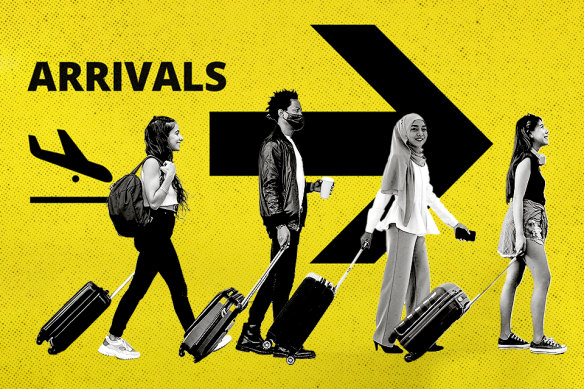Crackdown sees international student visa applications plummet
Visa applications from overseas students have roughly halved since higher fees and tougher rules came into play in July, realising the fears of universities who warned of an economic hit if new government policies lessened the demand for people to study in Australia.
In a sign the federal government’s crackdown is flowing through to the sector, there were drastically fewer applications from students in South and South-East Asia in July and August this year compared to the one before, while the vocational education sector had one-fifth of the offshore applicants it did a year ago.
Applications from students in India – the second-biggest source country for international education – were down 66 per cent.

Visa applications from international students have halved since July.Credit: Aresna Villanueva
There were 15,270 student visa applications lodged from offshore in August, less than half the 30,703 that were lodged in August 2023, and the lowest monthly number for August outside pandemic years since 2015.
Numbers were also significantly down in July, with 18,697 students applying offshore compared to 36,207 in 2023. Combined, the data available for this financial year shows 33,967 offshore student applications are almost half of the 66,910 from the year before – the lowest total for those two months since 2016.
The preliminary figures reflect visa application numbers, not visas issued, and the number of students enrolled in Australia remains higher than before the pandemic.
But the early fall in applications suggests the effect of Labor’s policies to bring down booming student numbers became more pronounced from July, which is when the government hiked student application fees from $710 to $1600.
The number of Indian students applying dropped by more than 8000 – from 13,047 visa lodgments in July and August last year to 4383 this year – while Nepali applicants fell from 4672 to 1944 and Vietnamese applicants dropped from 2617 to 1074.
Applications from prospective students in the Philippines and Pakistan almost dried up: Filipino applications went from 5126 to 849, and Pakistani applications from 4234 to 616.
But Chinese applications were far more steady, with the 12,012 applications lodged in July and August this year, representing 1100 fewer than the same period the year before.
The figures show the effect of Ministerial Direction 107, which Labor introduced in December to slow visa processing and identify non-genuine students. In practice, it has meant fewer students from South Asia have been approved for visas, and regional universities in particular have lost enrolments.
Education Minister Jason Clare said the government was implementing a “managed system for the international education sector, which strengthens integrity and makes it more sustainable”.
“Australia will continue to welcome international students in a way that is sustainable and reinforces quality for all students,” he said.
Professor Andrew Norton, a higher education expert, said a range of migration policies had made things more difficult for students and was putting them off applying to study in Australia.
“What’s driving it is a mix of very low success rates, the visa fee has more than doubled, the English language requirement has increased, the amount of money they need to show they have,” he said.
“The Indian market is very sensitive to migration policy and costs, so we’re seeing them way down. The Chinese market is less sensitive to those issues so it’s been reasonably resilient.”
Norton said university applications had dropped, from 36,015 in July and August 2023 to 20,445 this year, although they were fairly similar to pre-COVID-19 levels.
But visa applications for vocational education and training were “way, way down”, from 10,916 to 2239, as shonky operators had been targeted by the government.
Immigration expert Abul Rizvi said it was difficult to say which of the many changes from the last 12 months was having the greatest effect, but the most recent major change was hiking student visa fees.
“The government would be happy in the sense it will help them to get to the lower net overseas migration [figures] they are promising,” he said. “But if I were the government, I would be asking myself: ‘why am I going through all this pain with student caps if I don’t need to?’”
Both Rizvi and Norton said the figures suggested many institutions wouldn’t reach the new international student caps that the government wants to introduce from next year.
Universities Australia chief executive Luke Sheehy said the government’s crackdown had so far cost Australia’s economy $4 billion.
“This is what happens when international students are told to stay home, which is effectively what the government has been saying since it introduced Ministerial Direction 107 last December,” he said.
“Every day this direction is in place is another day the economy and our universities take a financial hit. It needs to go now.”
Cut through the noise of federal politics with news, views and expert analysis. Subscribers can sign up to our weekly Inside Politics newsletter.